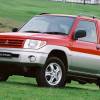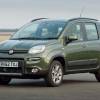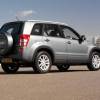
RAC sale – up to 33% off*
• Roadside cover from £5.29 a month†
• We get to most breakdowns in 60 mins or less
• Our patrols fix 4/5 breakdowns on the spot

BY ANDY ENRIGHT
Introduction
There's something about a Jeep Cherokee that's distinctly definitive. After all, the Cherokee first arrived here in 1993 with left hand drive imports having been available since as far back as 1984. It rapidly became a premium product, in huge demand amongst urban trendies. As it grew older it fell from favour a little, but the all-new model, introduced in 2001 has resurrected the Cherokee as one of the 'must have' 4x4s. Tracking down a decent used example isn't easy, as many owners aren't keen on being parted with their slice of prime American beef.
Models
Models Covered:
Third generation Cherokee - 2001- to date: (Five-door four-wheel drive Estate: 2.4, 3.7 petrol 2.5, 2.8 diesel [Sport, Limited, Predator])
History
When it was launched in the UK in 1993, the Cherokee wasn't exactly box-fresh, having already served an eight-year commission across the pond. Nevertheless, British buyers soon took it to their hearts and for a brief period in the mid-nineties a Cherokee was a far safer investment than bricks, mortar, gold or the BCCI. It was relatively affordable and it made an interesting alternative to the existing crop of 4x4s that were either resolutely agricultural or self-consciously effeminate. Here was something that the Marlboro Man would probably drive when his horse went in for its 12,000-mile service.
Given this rugged appeal, it was easy to forgive the Cherokee's faults. There was less rear-seat space than you'd find in a Peugeot hatch and the fake wood trim looked like something purloined from a motel that charged by the hour. Nevertheless, in those boom years when fuel was merely extortionate, the Cherokee made a strange kind of sense. Even when Jeep tried to replace the thing with the Grand Cherokee model, for that was its purpose, UK buyers stayed loyal and the Grand Cherokee was subsequently positioned as an upscale alternative.
Towards the end of its days, the old square Cherokee didn't even make the invite list in comparison tests with the better compact SUVs such as the Ford Maverick and the Land Rover Freelander and the time had come for something completely different. The 'new' Cherokee is cut from different cloth. Dubbed the Liberty in the US, where customers had grown fatigued by a new Cherokee every month, this latest model takes a fundamental appraisal of all things Jeep and shamelessly slathers these design cues liberally about itself. The Cherokee remained largely unchanged bar the introduction of a more powerful 2.8-litre version in 2003. Then in 2005 the Jeep was subjected to some mild upgrades and a styling refresh. Would-be buyers can sport these models by the shapelier bonnets and 7-slat grilles.
The Cherokee's popularity was on the slide by early 2006 when Jeep added a more advanced ESP system to deliver improved on-road traction for driving on snow, ice or wet surfaces. Prices were cut at the same time to help it compete with more modern rivals. Only the 3.7 V6 and 2.8 CRD engines were available by this stage although a Predator special edition with the 2.4-litre petrol unit was offered for a while. A brand new Cherokee was launched in August 2008.
What You Get
A vehicle that's loaded with equipment and ability (both on and off-road). The interiors display a fair degree of plastic hide and there's a cutesy 'round' theme going on, with round door handles and air vents and broad arcs on the instrument binnacle and door trims. What's perhaps a pity is that this is probably the first Jeep model that could have been built by anybody else. Whether this is a compliment given the excellence of some of the emerging rivals or an indictment of the watering down of the Jeep bloodline depends on your standpoint. What's not up for debate is that it's a better car than before.
What You Pay
Please fill in the form here for an exact up-to-date information.
What to Look For
The turbo diesels need their oil changed far more regularly than the petrol models so check the vehicle's service records to make sure the former owners have done so. The petrol-powered cars have no known problem areas, but like the diesels, a service history is essential in any vehicle that may have had even occasional off-roading. Check the underside for signs of off-road damage, as even with a Cherokee it's possible to duff the exhaust, the wheel arch liners or the axle.
The interiors are, in the main, well assembled, but check that all the 'convenience' features (electric windows, etc) live up to that name. Check the sunroof, door-locks and mirrors for trouble-free operation.
Replacement Parts
(Based on an Cherokee 2.5CRD- approx excl VAT) A replacement clutch assembly will be about £175. Front dampers are about £75 a pair and rears roughly £70. A set of front brakepads will be around £40, a new alternator around £280 and a starter motor close to £375. A replacement door mirror is about £150 and a radiator £250.
On the Road
Ride quality was improved enormously over its predecessor, due in no small part to a revised suspension system that replaced the antediluvian solid rear axle setup. Independent front suspension is a first for a Cherokee, as is a unibody construction, ditching the traditional separate ladder-framed chassis. At this point, the purists will probably be crying into their Buds, thinking that Jeep has sold out, but off-road performance is not markedly diminished. Ultimate wheel articulation is still impressive and Jeep have tested the Cherokee on the definitive off-road course, California's Rubicon Trail. This 22-mile route is so arduous it normally takes four days, but the Cherokee dispatched of the Big Sluice, The Rock Garden and Cadillac Hill in 48 hours.
There's a choice of an entry level 2.4 Sport, a 211bhp 3.7-litre petrol engine, a 143bhp 2.5-litre CRD diesel available in either Sport or Limited guise or a 2.8-litre CRD offered with the same trim choices. The Limited look is identifiable by body-coloured bumpers and wheel arches outside and satin-chrome detailing indoors. The 3.7-litre petrol is effectively the Grand Cherokee's V8 with a couple of cylinders lopped off and is a vocal companion which may boost the excitement factor but does little for motorway refinement. The majority of UK customers will instead plump for the 2.5-litre turbodiesel, and its ability to average nearly 30mpg makes sound financial sense. The oil-burner feels significantly more nimble than the V6, although it's performance figures will have you pencilling in tracts of your diary for it's sprint to 60mph. Okay, so that's a slight exaggeration, but 14.8 seconds is a comparative age in this class, and the 102mph top speed isn't going to generate too many column inches for the Cherokee.
Nevertheless, drive the car on its torque and it feels suitably muscular by dint of a hardly inconsequential 253lb ft of twist action. Rack and pinion steering sharpens things up, and should you wish to venture off road, you'll find authentic low range gearing. The turbodiesel and the V6 models differ in their off-road hardware, the petrol engined car opting for a more sophisticated centre differential, while the CRD utilises a more rugged solid locking system that allows the car to be run on-road in rear-wheel drive mode, with consequential economy benefits.
Overall
When shopping for a family-sized 4x4, you really do owe it to yourself to try the Jeep Cherokee. It's the real deal, the genuine article, the standard by which all the rest are judged. These days the rivals are a good deal tougher, but the Cherokee still has a good deal to commend it. A well looked after used Cherokee will last for years and has many strings to its bow. We'd opt for a 2.5-litre CRD or the later 2.8-litre CRD which replaced it and try not to look smug when copy cat 4x4s pull up alongside at the lights.

![Jeep Cherokee [KJ] (2002-2007) used car review](https://d1ix0byejyn2u7.cloudfront.net/drive/images/made/drive/images/remote/https_d2yv47kjv2gmpz.cloudfront.net/filestore/5/0/7/1_1a7fc3f73f4a5e1/a77c0314936f46681ff5cbe676eca085/1705_41b4b9a9735aca6_794_530_70.jpg)


![Land Rover Range Rover [L405] (2012-2017) used car review](https://d1ix0byejyn2u7.cloudfront.net/drive/images/made/drive/images/remote/https_d2yv47kjv2gmpz.cloudfront.net/filestore/3/4/7/1_f26dbf35d388061/7f71140bab752f40733ae854b7e0e49b/1743_10ea73e32c8f77f_100_100_70_c1_c_c.jpg)


